
|   |

|   |
Mukteswar Dance Festival 2021 - Nita Vidyarthi e-mail: nitavidyarthi@gmail.com Photos courtesy: Odisha Tourism February 6, 2021 The three-day Mukteswar Dance Festival (Jan 14-16, 2021), organised by Odisha Tourism in association with Odisha Tourism Development Corporation and Odisha Sangeet Natak Akademi is a much awaited exclusive Odissi dance event, drawing a large number of artistes, dancers, connoisseurs and tourists from home and abroad. Staged at the premises of the beautiful Mukteswar Temple, the 10th century architectural wonder nestled at Bhubaneswar, the format of solo, duet and group dance performances has been retained since its inception in 1984 by Dr. Subas Pani on the occasion of the Golden Jubilee of The Odisha State Museum. The post pandemic situation did not much make a difference in the familiar sight of arrangements, decoration and set up, excepting for the slightly smaller number of the audience, all masked, sitting apart from each other. The sprawling stage had the usual look with the idol of Lord Nataraja on the front corner, musicians sitting on the other, hustle bustle of the photographers in the front bench, busy DD Bharati and National television channel personnel complete with the inauguration each evening by dignitaries with the lighting of the lamp from the wick of the flame from the Ganesha Parsha Devata in the adjacent Siddheswar temple brought by an Odissi dancer each evening, thus marking the commencement of the festival. 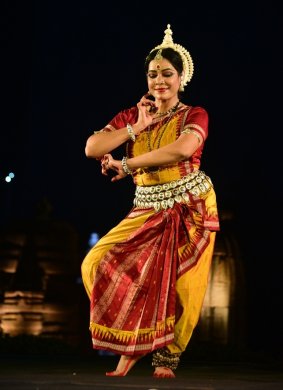 Meera Das But this year, this review rests on the telecast viewing. Every evening began with a chorus by renowned vocalists and musicians in praise of Lord Shiva. After the inauguration, the first evening began with a soulful Shiva Vandana by Naad Ninad from Cuttack conducted by Maheswar Rao and group. The dance performances were opened by the renowned Odissi dancer Meera Das of Cuttack whose expressiveness of the Odissi body is utterly unique and the grammar of execution undiluted as trained by her legendary Guru Kelucharan Mohapatra. The mangalacharan "Yang Brahma Varuney" in raga Bairagi, ektali was dedicated to Lord Shiva followed by the succession of intricacy of steps of Bilahari Pallavi, the pure dance item composed by her guru with the rhythm of Satchidananda Das' mardal set to Pt Bhubaneswar Misra's music, and vocals by Rajesh Lenka. She recounted intensely the "Atmanivedana" of Shabari in her self-choreographed abhinaya piece from the Ramayana with imagination and mature understanding, etching memorable moments like "Prem sahit Prabhu khayey" while offering the half tasted berries to Lord Rama who eats it with joy and the final "Sri Ram Jai Jai Ram." Support of Agnimitra Behera's violin and Nazia Alam's singing enhanced the appeal.  Reebdhita Barua & Preetisha Mohapatra The sparkling duet 'Anwesana' by two consummate dancers, Preetisha Mohapatra and Reebdhita Barua of Srjan commenced with a devotional hymn in praise of Lord Shiva, followed by the pure dance number 'Yugmadanda Pallavi' in raga Bagesri, ektali where the young dancers showed their unerring grip on rhythm and vocabulary. They concluded with Ram Stuti set to Goswami Tulsidas' "Sri Ramchandra kripalu bhajamana" proving their abhinaya skills with perfect coordination, so essential to make a duet a success. Beautiful dancing to the mardala and scintillating choreography of Ratikant Mohapatra, spiced with Pandit Raghunath Panigrahi and Pradip Das's music composition in raga-talamalika, Jatin Sahoo's singing, Prakash Kumar Mohapatra's sitar, Srinibas Satpathy's flute, Agnimitra Behera's violin and Ekalavya Maduli's manjira made for a fine viewing experience. 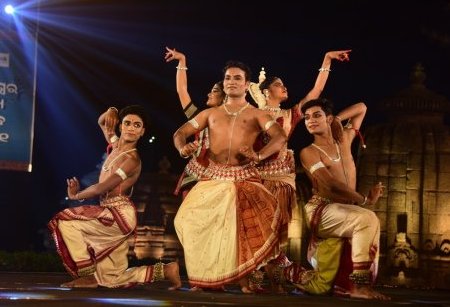 Lingaraj Pradhan & group The evening concluded with a suite of three numbers featured by Lingaraj Pradhan and his skilfully trained, well rehearsed group of Utkal Sangeet Mahavidyalaya. The first number "Vighna Vinayaka" scripted by the erudite Sanskrit scholar Pt Nityananda Misra was an invocation to Lord Ganesha by three male and six female dancers with expert dancing especially in the imagery of "Mushika vahana pahimam" in good formations set to the hymn "Sri Ganesham Vighnarajanam Gaurishankaranandanan". The music with a devotional flavour was by Dr. Bijay Kumar Jena and rhythm by Bijoy Kumar Barik. In tala khemta based Kirwani Pallavi composed by Guru Kelucharan Mohapatra, the dancers negotiated the intricate rhythms of the nritta item confidently. 'Shakti' based on the stotras of Dasamahavidya saw strong intense moments of dancing, with imagery of Kali, Ma Chamunda, Chanda-Munda Shumbha-Nishumbha Vinashini in the 'kathakathan' (story telling) format. The piece had a dramatic appeal visual imagery primarily due to its strength of movements, marvelous feats and harmony in execution. Lingaraj deserves a word of praise not only for his part solo execution but for the use of bhramaris, tribhangis, a few utplavanas and a stunning formation with a visually beautiful final frieze in his choreography. The dance compositions of the first and last numbers were by Lingaraj Pradhan and Pankaj Pradhan. Supporting musicians were Budhanath Swain on the mardala, Nimakanta Raoutray on vocal, Prashant Padhi on the violin and Sitakant Jena on the manjira. 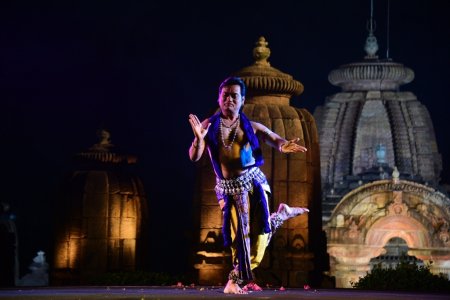 Ramesh Chandra Jena Tall and robust Ramesh Chandra Jena took entry for his technically brilliant solo "Haragauri Asahtaka" in the second evening after the opening Shiva Vandana "Uma Maheshwara Namoh" by Swapneswar Chakravarty and his group which also included singer Dr. Sangita Gosain. A disciple of Guru Gangadhar Pradhan and later Aruna Mohanty, the strapping dancer from Orissa Dance Academy, did full justice to the premises of Mukteswar, a 'Shaiva pitha', exploring the various possibilities of movements and body inflexions of the dance form based on the Ardhanareeswara principle of life's polarity where the male and female are a harmonious whole. The piece was choreographed by Guru Bichitrananda Swain set to Guru Ramhari Das's music and vocals and Dhaneswar Swain's rhythm. And he danced like a man! His concluding abhinaya piece 'Bishwaprakasha' scripted by Kedar Misra was set to music by Ramhari Das and Gopal Chandra Panda with Bichitrananda Swain and Aruna Mohanty's choreography and rhythm by Dhaneswar Swain and Bijoy Kumar Barik, discovered spirituality, based on the poem by the tribal blind poet Bhimo Bhui, believing on "Nirakara Brahma." The finest elements of execution from tandava to lasya and vice versa, from slow to progressing speed at the end unfolding the poetic essence, reappeared in the complete surrender to the Almighty with a final shashtanga pranam (prostrate salutation) set to Rupak Paridha's singing of "Jagata udhar roheyhew." Another soulful number was "Suryacha cha chandramashcha..." at the start with a totally controlled slow and steady Bhramari and the visual imagery in "Na thila a prithvi proloya utpati na thila jalapabana" (The earth was not there, no air or water...). 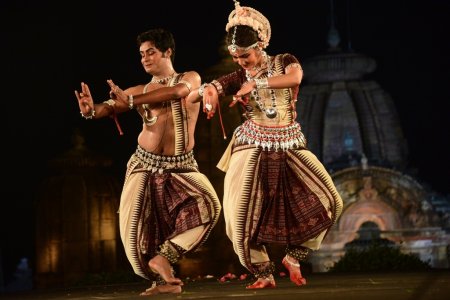 Niladri Mohanty & Shatabdi Mallick Since in Mukteswar, from the Debaprasad Gharana came a quality duet dedicated to the presiding deity Mukteswar by powerful dancers Shatabdi Mallick and Niladri Mohanty, choreographed by their Guru Durgacharan Ranbir. They began with the mangalacharan "Shivarupa Mahadevanko dhyanam" that is performed in the Brajeswar temple of Kumbhari Village of Sambalpur using chari, karanas and mandalas. The dancers created a spectrum of fascinating movements in perfect sync and technical brilliance of which the bhumipranam celebrated the devotional fervour of the ancient temple. As Kali on the final stance of Shatabdi standing on Mahadeva (Niladri) was gripping as was the Urdhalinga Mahadeva pose! A fine entry with "Hey Sadashiva Hey Mahadeva Madhavpriyo Sri Gaurishankara" in Sukanta Kundu's voice marked the abhinaya piece "Baidyanath panchapadi" by the duo clad in matching maroon bordered white costumes. The piece saw a lot of nritta, embellished with Dhaneswar Swain's ukuta supported by Abhiram Nanda's flute, Pradip Rai's violin and Prakash Das' sitar. 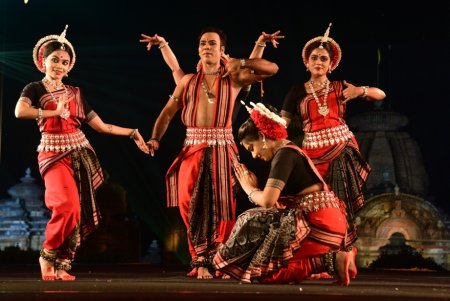 Diksha Manjari Dona Ganguly's group Diksha Manjari led by senior seasoned dancer Raghunath Das proved their solid training through confident and well-rehearsed dancing in the opening Dasavatar in raga Mohanam, tala jhampa composed by Guru Kelucharan Mohapatra set to music by Pt Bhubaneswar Misra followed by a crisp Shankarabaranam Pallavi. They concluded with an impressive Ardhanareeswar. Celebrity musicians like Ratikant Mohapatra on the mardala, Ramesh Chandra Das on the violin and Rajesh Lenka on the vocals offered support. Dona could not be present because her husband "Dada" Saurav Ganguly was indisposed. 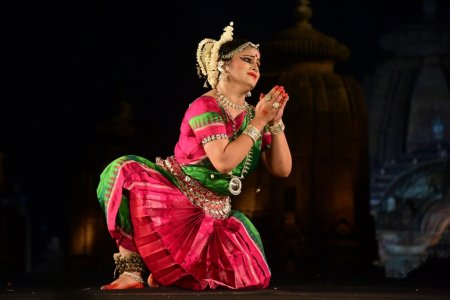 Sonali Mohapatra The final evening opened with the talented Sonali Mohapatra's mangalacharan 'Nilakanta Stuti' set to raga Ahir Bhairava, ektali after the chorus by eminent musician Srinibas Satpathy's group eulogizing the glory of Lord Shiva. A brilliant dancer of the Debaprasad Gharana trained by Guru Durgacharan Ranbir, her steady strides and movements with the refrain of Mukteswaraya Namah had the necessary skills to project the thematic content with Sukanta Kundu's singing and Dhaneswar Swain's rhythm. Pallavi set to raga Saranga choreographed by her proved her technical abilities and her abhinaya in "Na janigo pirati jaha Kali" in Durgacharan Ranbir's choreography unfolded the appeal of the lyrics effectively. 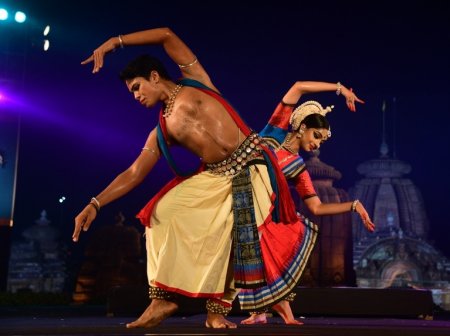 Pratap Kumar Barik & Sripunya Mohanty The best duet number of the festival in totality in terms of novelty in thematic content, choreography and presentation, not to say the competent execution was by Sripunya Mohanty and Pratap Kumar Barik. The Pushpanjali was linked with the Nagavolli Pallavi followed by a stunning abhinaya piece "Su mukha Gunakeshi" based on the iconic collection of love stories from Mahabharata transcreated by Subodh Ghosh entitled 'Bharat Premkatha' first printed in 1956 in Bengali. Choreography of both the pieces was by Aruna Mohanty. The Pallavi was captivating technically in the riveting choreographic successions executed by the skilled dancers but the gratifying moments were those from the abhinaya piece. The story revolved round the search for the right suitor by Indra's charioteer Matali for his beautiful daughter Gunakeshi. Finally Matali lands up in Bhoogbati, the abode of Vaasuki and is highly impressed to see the young Nagkumar Sumukh, grandson of Snake King Aryaka, son of Chikor. Matali expresses his desire to Aryaka but discovers that Sumukh's life is short. He faces the angst of Garuda who would kill him. Matali approaches Indra but the King of Gods cannot grant Amrita (nectar) for Sumukh. Instead, he graciously granted that Sumukh would be saved from Garuda. A series of events follow and when Garuda's shadow hovers round Sumukh, Gunakeshi sacrifices her sanctity and holds on to his chest and protects Sumukh from the bird's deadly scratches. Angered and frustrated, Garuda scorned, denounced her and left. When Sumukh asked her why she offered her chastity she explained that she wanted to turn his death itself nectareous with love even at the cost of being called a loose woman. There are some impassionate moments that sensitively transports the text to visual imagery set to songs like "Jiban madhur nahi ki.....", "Pranoy rahi kantakao, premer mulya achhi ki" (the value of love). The dancers offered a marvellous coherence with the choreography, music by Gopal Chandra Panda assisted by Sangita Panda and the classicism of rhythm by Dhaneswar Swain and Bijoy Kumar Barik .The kinetic phraseology of the unusual turns of the lower torso and crystalline forms of choreography offered a stylised imagery. With text inputs by Kedar Misra, the performance unfolded the deeper meaning of love through refinement of forms to luxuriate upon the introspection and exploration of rhythmic layers, musical time and stage space. 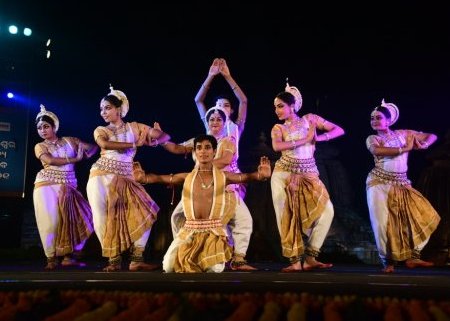 Jyotsnarani Sahoo & group Dazzling with white and gold costume, Jyotsnarani Sahoo and group of Soor Mandir, Cuttack, concluded the festival with the mangalacharan "Vandana Shivamaya" followed by a geetabhinaya "Rasanurag". The piece had a ballet feel and was pleasing. The closing Keerti Kalavati garlanded with nritta set to sargams was a fine piece and an impressive ending. The music was by Swapneswar Chakravarty. Dr. Srinibas Ghatuary and Samhati Pani anchored the program. 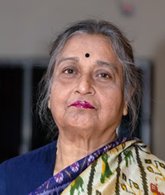 Dr. Nita Vidyarthi is a veteran critic of performing arts and writes on dance, music and theatre in leading publications. |